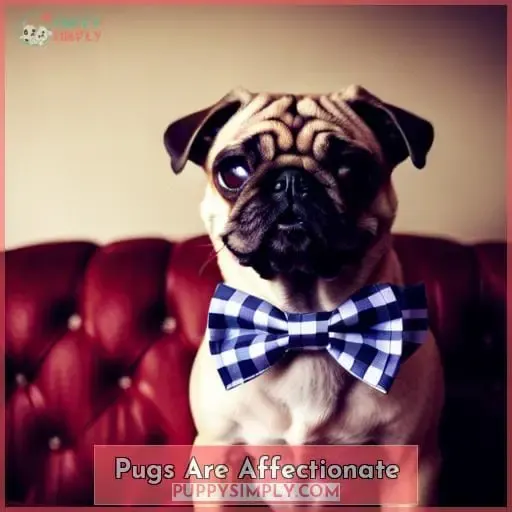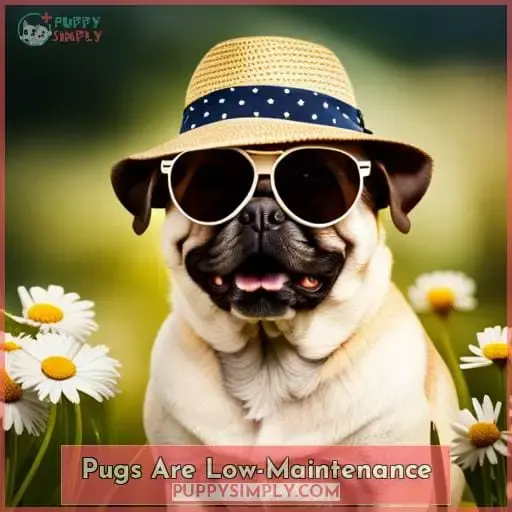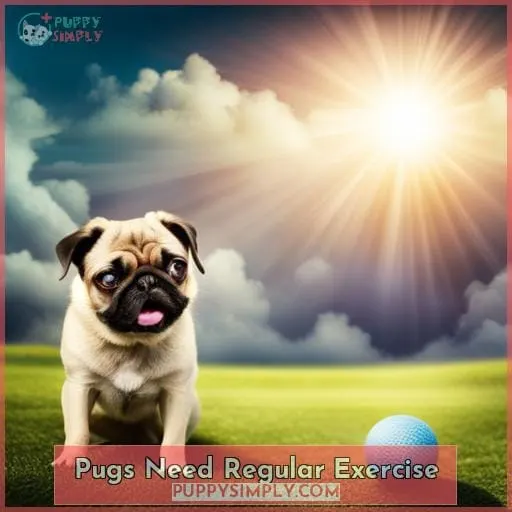This site is supported by our readers. We may earn a commission, at no cost to you, if you purchase through links.
 Pugs are affectionate, playful, smart, and low-maintenance.
Pugs are affectionate, playful, smart, and low-maintenance.
They get along well with other animals and are adaptable to different living situations.
If you’re looking for a loving companion, a Pug may be the perfect dog for you.
Table Of Contents
- Key Takeaways
- Pugs Are Affectionate
- Pugs Are Playful
- Pugs Are Smart
- Pugs Are Low-Maintenance
- Pugs Are Adaptable
- Pugs Get Along Well With Other Animals
- Pugs Need Regular Grooming
- Pugs Need Regular Exercise
- Pugs Need a High-Quality Diet
- Pugs Can Be Prone to Health Problems
- Frequently Asked Questions (FAQs)
- Conclusion
Key Takeaways
- Affectionate, playful, and smart
- Low-maintenance and adaptable
- Regular grooming and exercise required
- Prone to certain health problems
Pugs Are Affectionate
Pugs are often described as being affectionate dogs, and you’ll quickly find that they live up to this reputation.
They’re loyal, cuddly, gentle, loving, and playful. They make great companions for people of all ages, and they love to be around their families.
However, they can also be prone to separation anxiety, so it’s important to make sure that they get enough attention from their owners.
Pugs Are Playful
When you get home from work, you’ll be greeted by your playful pug.
Pugs are energetic, curious, and mischievous. They love to play fetch, tug-o-war, and go for walks.
While pugs are generally easy to train, they can be stubborn at times. They also tend to bark a lot, especially when they’re excited or bored.
However, their playful nature and loving personality make them a great addition to any family.
Pugs Are Smart
Pugs aren’t only playful, but they’re also smart and easy to train.
These little dogs are quick learners and have an innate cleverness that allows them to pick up commands and tricks with ease.
While some pugs can be a bit stubborn at times, their intelligence makes training sessions fun and rewarding for both you and your furry friend.
They respond well to positive reinforcement methods, especially when food rewards are involved.
However, it’s important to keep in mind that pugs may experience breathing problems due to their shortened snouts, so it’s essential not to push them too hard during physical activities or training sessions.
Pugs Are Low-Maintenance
If you’re considering owning a pug, you’ll be pleased to know that they’re relatively low-maintenance dogs.
Pugs don’t bark much and tend to sleep a lot, making them ideal for those who prefer quieter companions.
They’re adaptable and can easily adjust to different living environments, including apartments.
Pugs get along well with other animals and are known for their friendly nature.
However, it’s important to keep an eye on their weight as they’ve a tendency towards obesity if not properly managed through diet and exercise.
Overall, pugs require regular grooming but make up for it with their easygoing temperament.
Pugs Are Adaptable
As an owner, you’ll find that pugs are incredibly adaptable to various living situations.
They can live in apartments without any issues, making them a great choice for city dwellers.
Pugs are also highly adaptable to families and make excellent companions for children. Their friendly and affectionate nature ensures they get along well with kids of all ages.
Another aspect that makes pugs so versatile is their low-maintenance needs. While they do require regular grooming and shedding management, their overall care is relatively easy compared to other breeds.
Furthermore, pugs are known for their loyalty, which adds an extra layer of adaptability as they quickly form strong bonds with their owners regardless of the living environment or circumstances.
Pugs Get Along Well With Other Animals
Do pugs easily get along with other animals? Absolutely! Pugs are known for their docile and gentle nature, making them excellent companions for other animals.
- Friendly: Pugs have a friendly disposition and love to socialize. They’ll happily greet and interact with any animal they come across, whether it’s a cat, another dog, or even smaller pets like rabbits or guinea pigs.
- Loyal: Pugs are fiercely loyal to their family members, both human and animal alike. Once they form a bond with another pet in the household, they become devoted friends who’ll always be there for each other.
- Playful: Pugs have an innate playfulness that extends to all creatures around them. They enjoy engaging in games of chase or tug-of-war with fellow furry friends, creating endless entertainment for everyone involved.
- Easygoing: With their laid-back attitude and adaptable nature, pugs are able to get along with just about any animal. They’re not easily stressed or upset, and they’re always willing to give new friends a chance.
Pugs Need Regular Grooming
To keep your pug looking and feeling their best, regular grooming is essential.
Pugs have unique features that require specific care to maintain their health and appearance.
Their facial skin folds need to be cleaned every day to prevent dirt and moisture buildup, which can lead to infections.
Some pugs may also require trips to the vet for emptying of their anal glands, a common issue in this breed.
Additionally, it’s important to trim your pug’s claws every now and then as they can grow excessively long if left unchecked.
By incorporating these grooming practices into your routine, you can ensure that your pug stays happy and healthy.
Pugs Need Regular Exercise
Now that you know about the importance of regular grooming for your pug, let’s move on to another crucial aspect of their care: exercise.
Pugs may have a reputation for being couch potatoes, but they still need their daily dose of physical activity to stay healthy and happy. Aim for at least 45 minutes of exercise each day, which can be divided into short walks and playtime sessions.
It’s important to avoid strenuous exercise that could strain their breathing due to their shortened snout. Additionally, keep in mind that pugs are prone to overheating, so it’s essential to take precautions during hot weather and ensure they don’t overexert themselves.
Pugs Need a High-Quality Diet
Pugs require a high-quality diet to maintain their health and prevent weight gain.
- Avoid overfeeding: Pugs have a robust appetite, but it’s essential not to give in to their begging eyes and provide them with more food than they need. Overfeeding can lead to obesity, which can cause various health problems.
- Avoid obesity: Pugs are prone to gaining weight quickly if not properly managed. It’s crucial for owners to limit their food intake and measure the quantities they consume.
Pugs Can Be Prone to Health Problems
You should be aware that owning a pug comes with the potential for health problems.
Pugs are prone to various issues such as breathing problems, eye ulcers, skin infections, kidney stones, and bad teeth.
Due to their shortened snouts, pugs often experience difficulty breathing which can lead to respiratory distress.
They’re also susceptible to developing eye ulcers due to their prominent eyes.
Additionally, the folds of skin on their faces make them more prone to skin infections if not properly cleaned and maintained.
Furthermore, pugs have a higher risk of developing kidney stones and dental issues such as bad teeth due to their genetic predispositions.
Regular veterinary care is essential in managing these health concerns for your beloved pug companion.
Frequently Asked Questions (FAQs)
Are pugs good with small children?
Pugs are great with small children.
They’re friendly, affectionate, and make wonderful family pets.
Their small size means that kids may accidentally hurt them, so supervision is necessary.
How often should I brush my pug’s coat?
To keep your pug’s coat healthy and clean, it’s recommended to brush them at least once a week.
Regular brushing helps remove loose hair and prevents matting, ensuring their coat stays in good condition.
Do pugs have any specific exercise requirements?
Pugs have moderate exercise needs, requiring about an hour of activity per day. They adapt well to apartment living and enjoy short walks and playtime.
However, be cautious in hot weather as they’re prone to overheating.
What kind of diet should I feed my pug?
To maintain a healthy weight for your pug, it’s important to feed them a balanced diet of high-quality commercial dog food.
Be careful not to overfeed them as they’re prone to weight gain.
What are some common health problems that pugs may experience?
Pugs are prone to various health problems, including:
- Brachycephalic airway syndrome
- Eye issues
- Skin infections
- Hip or elbow dysplasia
- Pug dog encephalitis
Regular vet check-ups are crucial for their well-being.
Conclusion
To sum it up, owning a Pug can be a delightful experience.
Their affectionate nature, playful demeanor, and intelligence make them wonderful companions.
Pugs are also low-maintenance and adaptable, making them suitable for various living situations.
However, it’s important to note that Pugs require regular grooming, exercise, and a high-quality diet to stay healthy.
Additionally, they can be prone to certain health problems.
Overall, if you’re looking for a loving and loyal pet, a Pug may be the perfect addition to your family.
















